How many times have you searched for a gluten free croissant recipe? Be honest. Probably not nearly as many times as you’ve craved one!
You couldn’t be blamed for missing those light, flaky layers of buttery heaven. I certainly have.
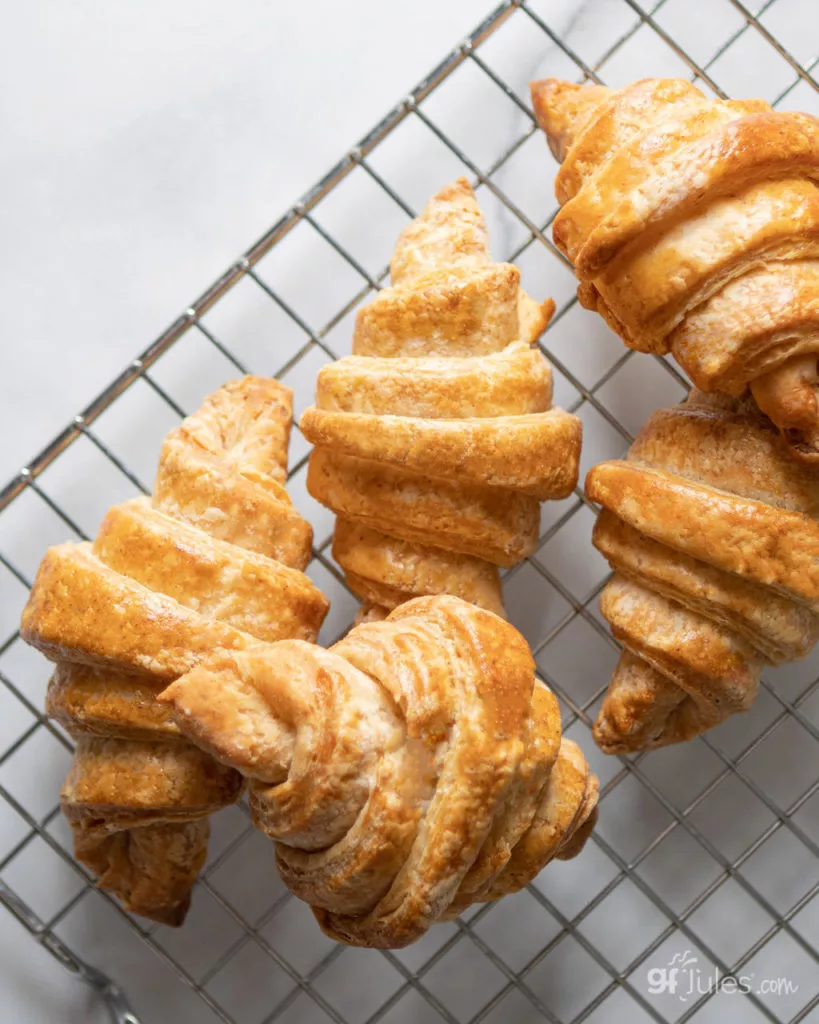
I’ve personally been asked for a gluten free croissant recipe more often than I can recall, and I always point people to my easy gluten free crescent rolls recipe for the shaping technique, but recommend that folks use my gluten free puff pastry recipe for the dough.

Seems like that combination would produce a close approximation to a gluten free croissant — at least it would get you in the neighborhood! My yeast-leavened gluten free puff pastry recipe is divine and super versatile, easy to shape and makes a spot-on Danish pastry (also in the broader croissant pastry family), so why not? But it’s not quite the same.
So why have I never put the two together into an official gluten free croissant recipe before now? I don’t honestly know for sure. It might have something to do with the fact that my “to-do” list is a mile long, but who’s counting?
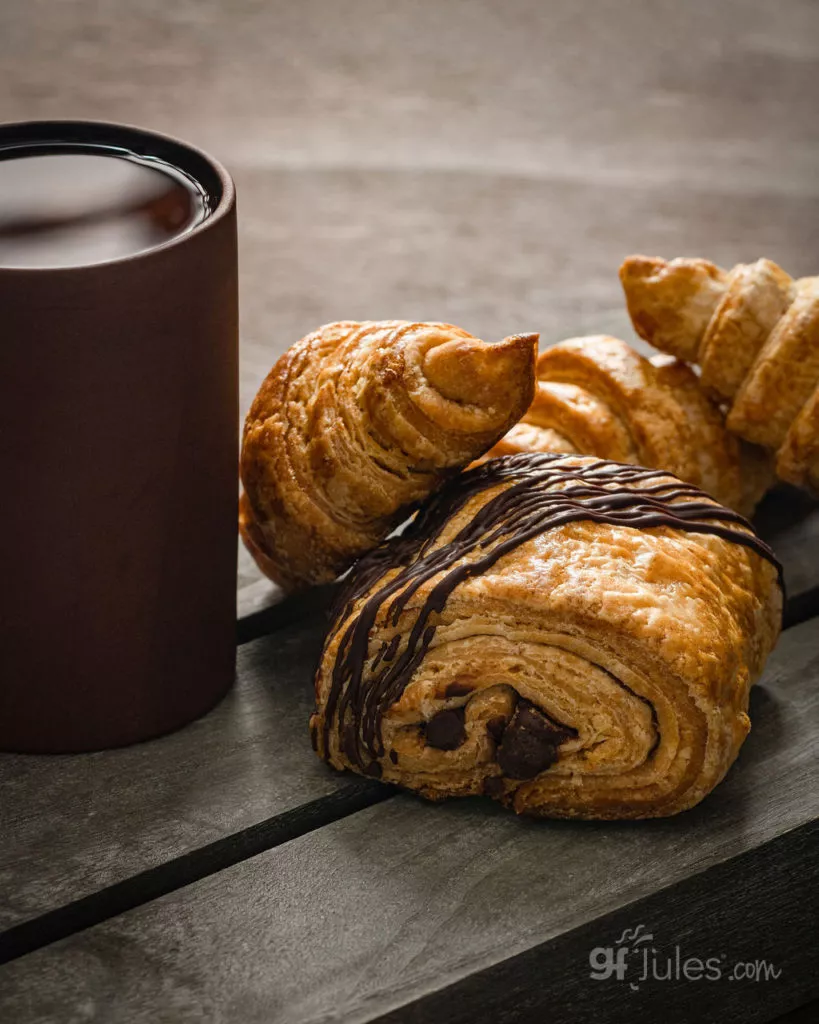
I certainly never doubted that making homemade gluten free croissants would be possible, or that they would be delicious. The one factor that concerned me a bit was how to make them in hours, not days … because who has days to make homemade gluten free croissants? (not me!)
You probably already know that my trademark gluten free recipe style is E.A.S.Y. Typical croissant recipes don’t fall into that category, do they? Kind of like gluten free baklava. Looking for that? Check out this recipe and video from a Greek friend who has used my gfJules Flour for a dozen years to make it, but it ain’t quick, either!
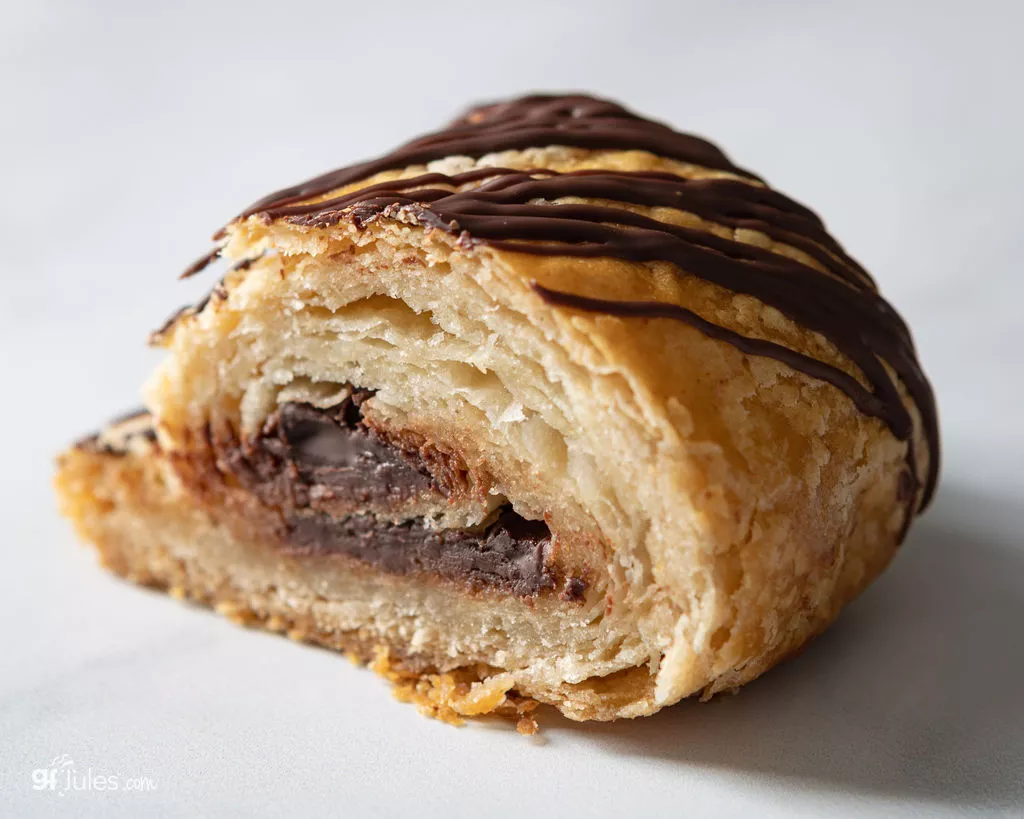
Back to the gluten free croissant recipe at hand. Most recipes take hours, and hours, if not days to make a great croissant. Add gluten free to the mix and, well, you can see where E.A.S.Y. might get lost in the shuffle. Enter Chef Ricardo Mora.
He and I have been working together on a few projects lately (you might have seen his gluten free bûche de Noël made with my gfJules Flour). When I floated the idea to him that perhaps he could undertake this pastry mission, he was actually pretty eager to tackle it.
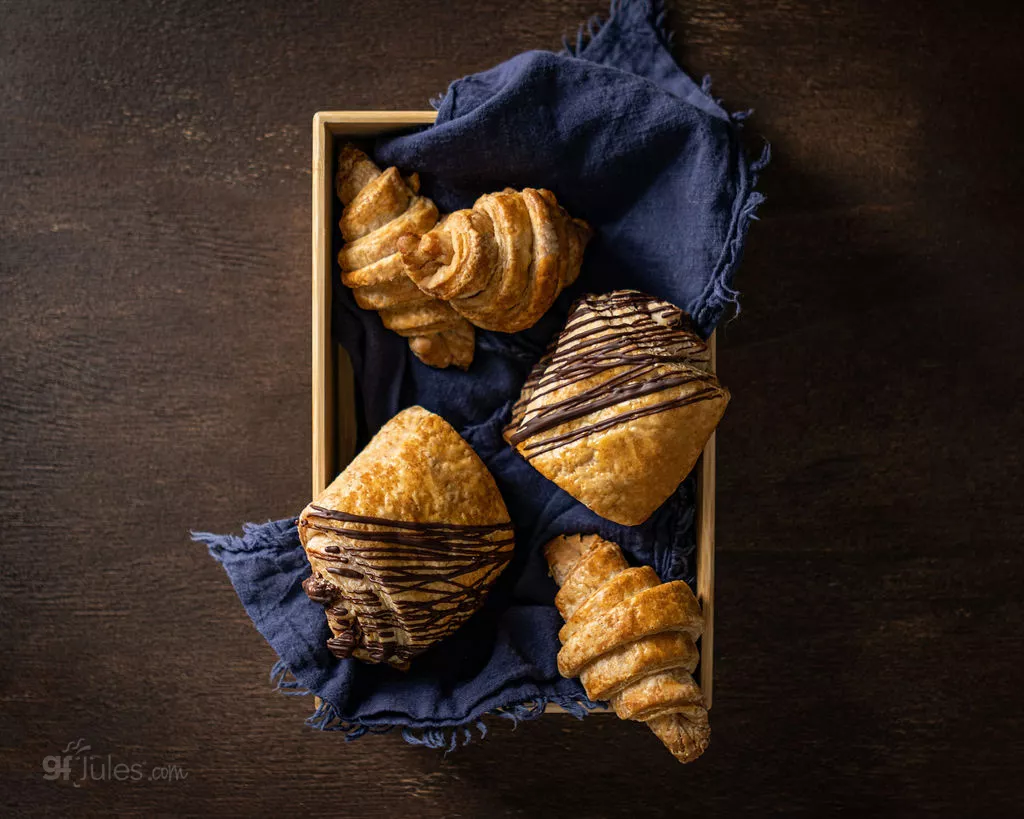
I have to hand it to him, this recipe did not disappoint! Not only is it legit gorgeous, authentically crispy, flaky and beautiful, but in his recipe, he has managed to skip right over the painstaking many many hours-long process that is so typical with croissant-making.
He embraced the gluten-less benefit of our gluten-free dough and doesn’t add time or steps for resting a dough when it doesn’t need relaxing.
Chef Mora is also gluten free and he was as excited as I was about having delectable gluten free croissants back without days of work to make them.
After so many years of not being able to have croissants, I was so happy with how these turned out. They are rich and buttery. The outside is crispy and flaky while the inside is very soft. GfJules All Purpose Flour Blend with the addition of some psyllium powder made the dough very easy to work with and shape. I will definitely be making these again soon.
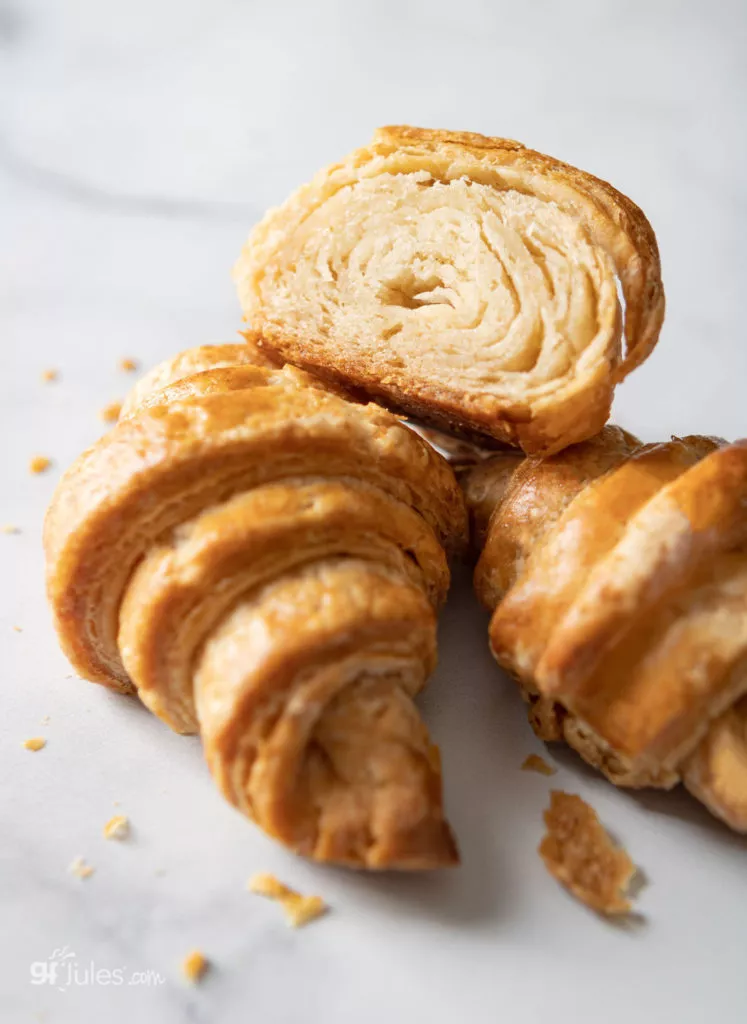
He even came up with a way to make these croissants and freeze them to bake later — genius!
The refrigeration steps are another story. They couldn’t be avoided because, well … butter.
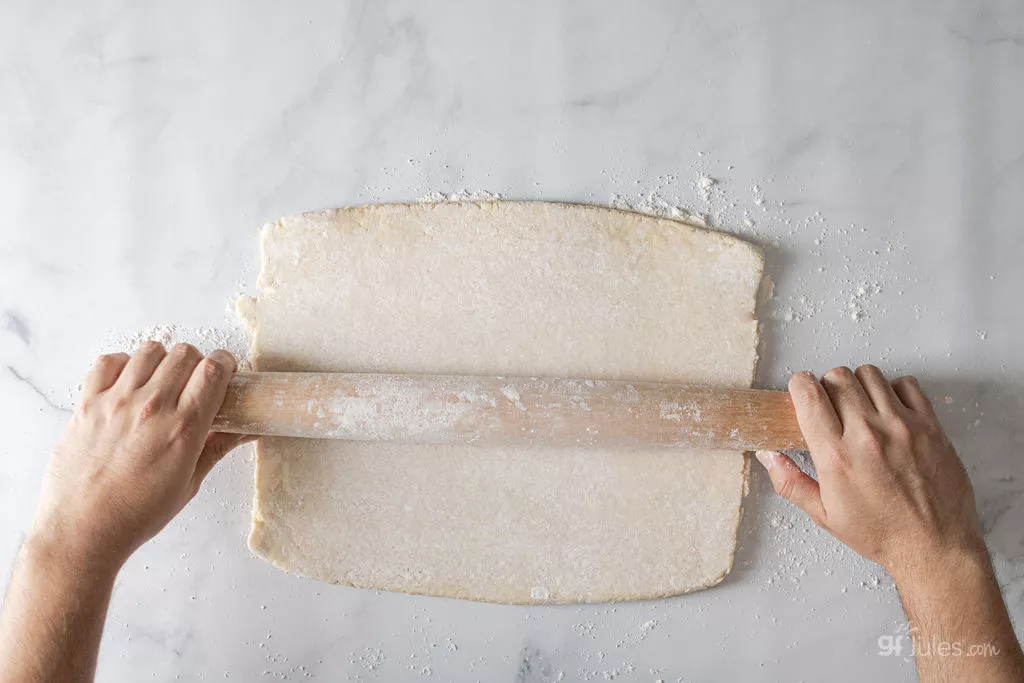
Laminating Gluten Free Dough
Butter (or its vegan counterpart) is KEY to croissants. And the butter lamination step is one of the reasons that croissants have that hallmark flakiness (lamination is the process of sheeting and folding butter into the dough).
But the butter needs to stay cold enough while working with it not to melt, so you’ll likely need to keep sticking the dough + butter back into the refrigerator multiple times to keep it well below its 100°F melting point.
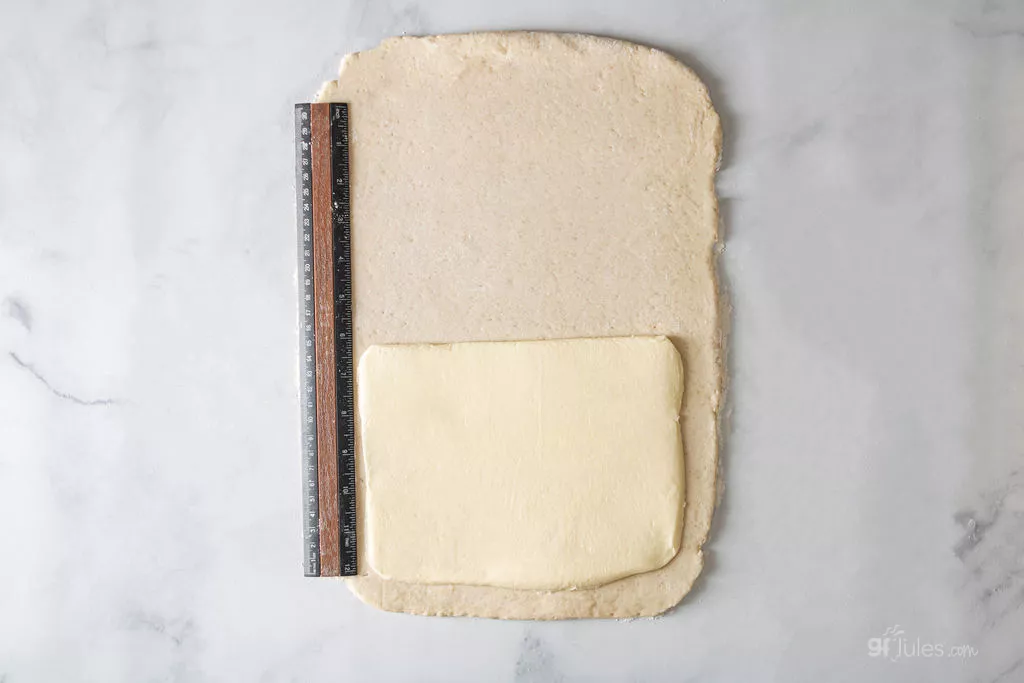
Start by rolling the dough out gently, then place a slab of butter half the dimensions of the rolled dough onto the bottom half of the dough.
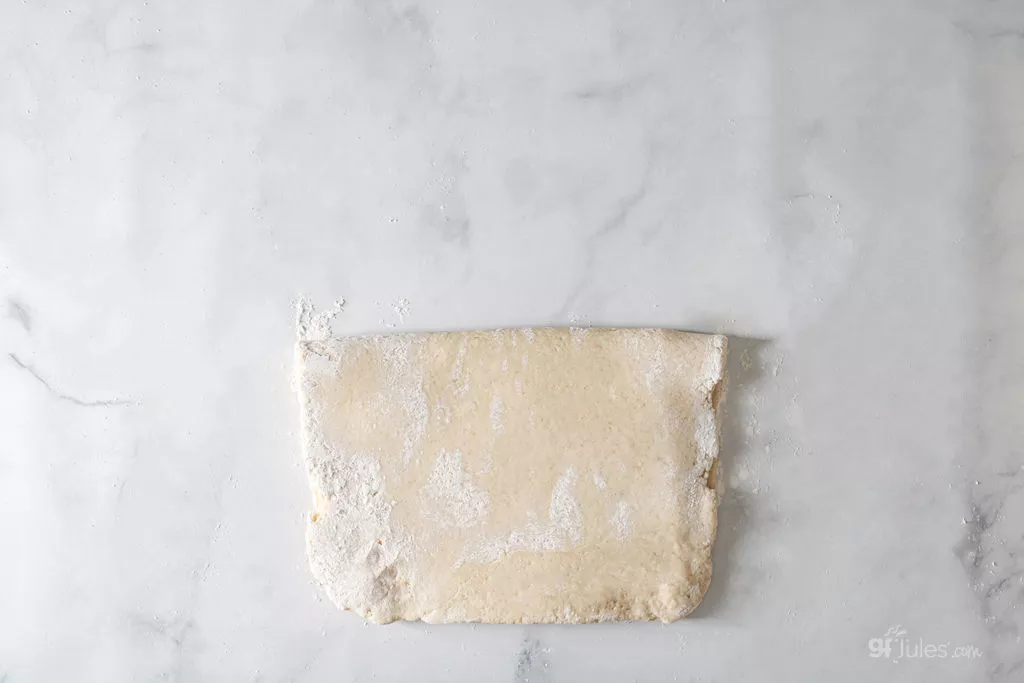
Then fold the top of the dough down over the slab of butter and seal the edges lightly (brush off excess gluten free flour so the dough will stick to itself better).
The steps here are called “book folds” — can you see why?
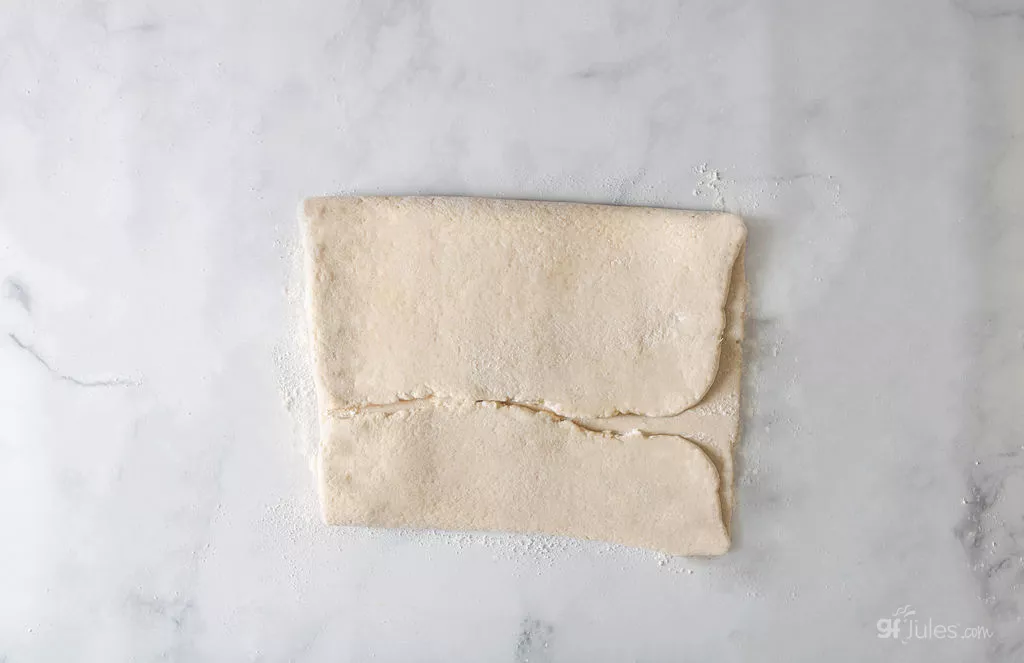
Then rotate the dough one-quarter turn, roll again and fold the top down and the bottom up (see the book!).
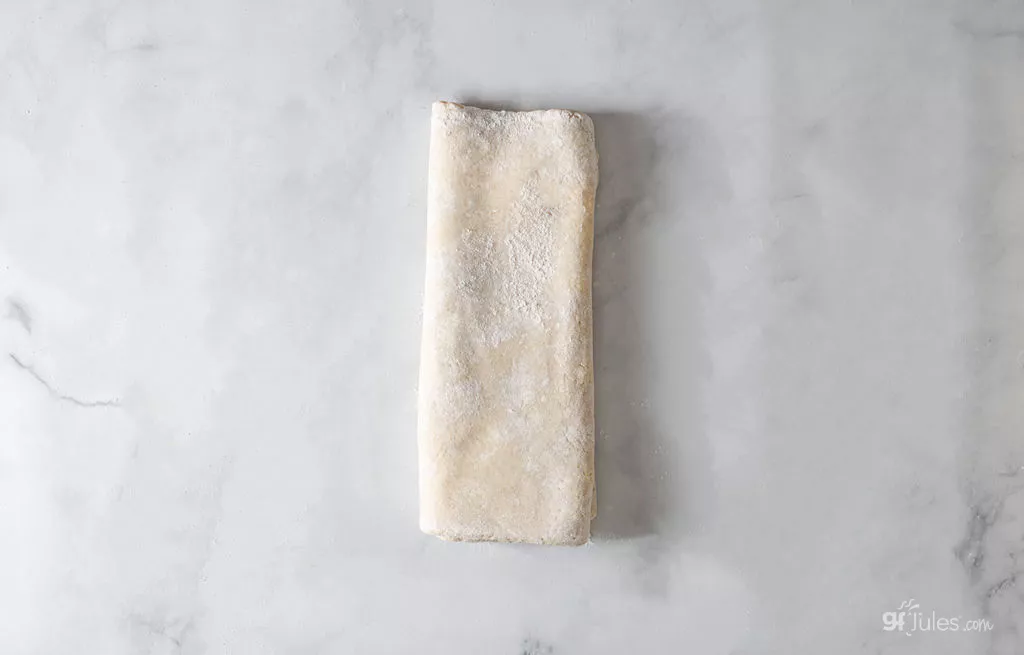
Rotate the dough one-quarter turn, roll out again and repeat the folding steps. (Rotating the dough is made easier with a bench scraper, available on my site)
If you’re really getting into a groove, you can repeat the turning step again, but don’t add more butter, as the butter proportion is perfectly configured for this recipe. Too much butter and you’ll have pastry sitting in a pool of it — not ideal.
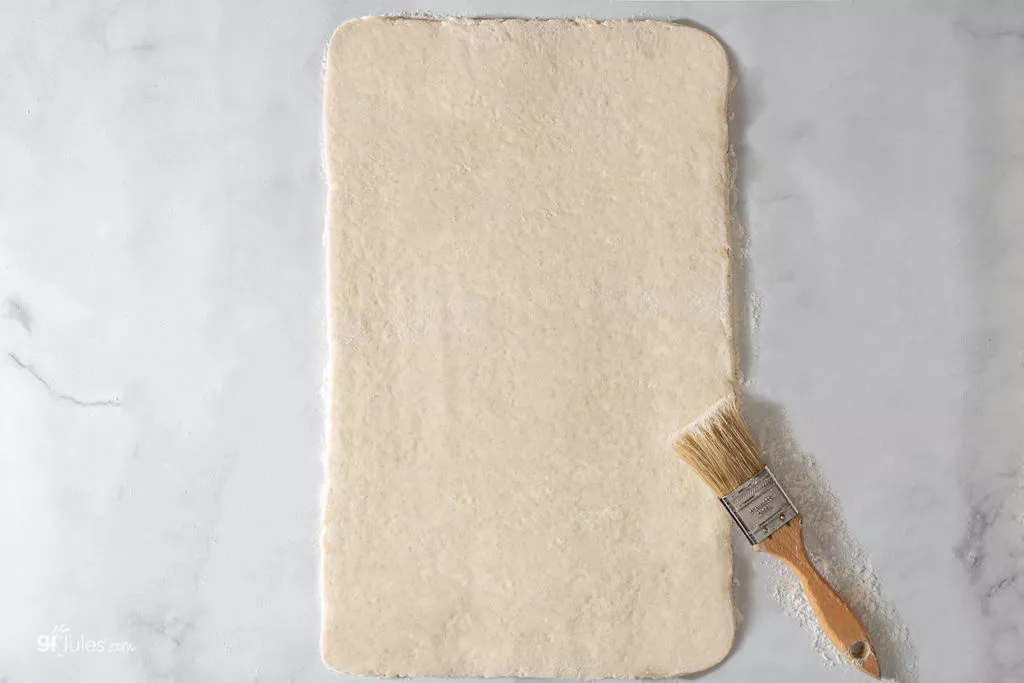
Keep brushing off any excess flour and remember that the butter must remain cold and not melt during this process, so if the dough needs to be wrapped in plastic and refrigerated at any time while you’re working with it, please do so.
Shaping Gluten Free Croissant Dough
After the lamination steps, the dough will go into the refrigerator to get nice and cold. At that point, the shaping fun begins!
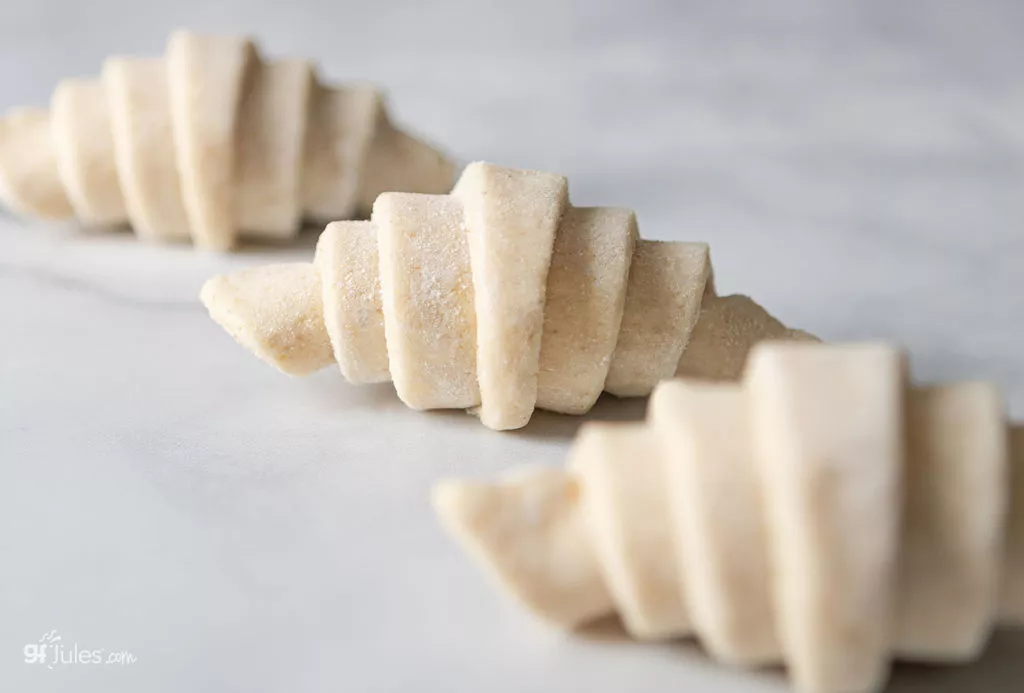
The dough is easy to work with because my gfJules Flour supplies the stretch and pliability needed, and of course the lightness and smooth texture everyone seeks in a great croissant. You can see that the results speak for themselves!
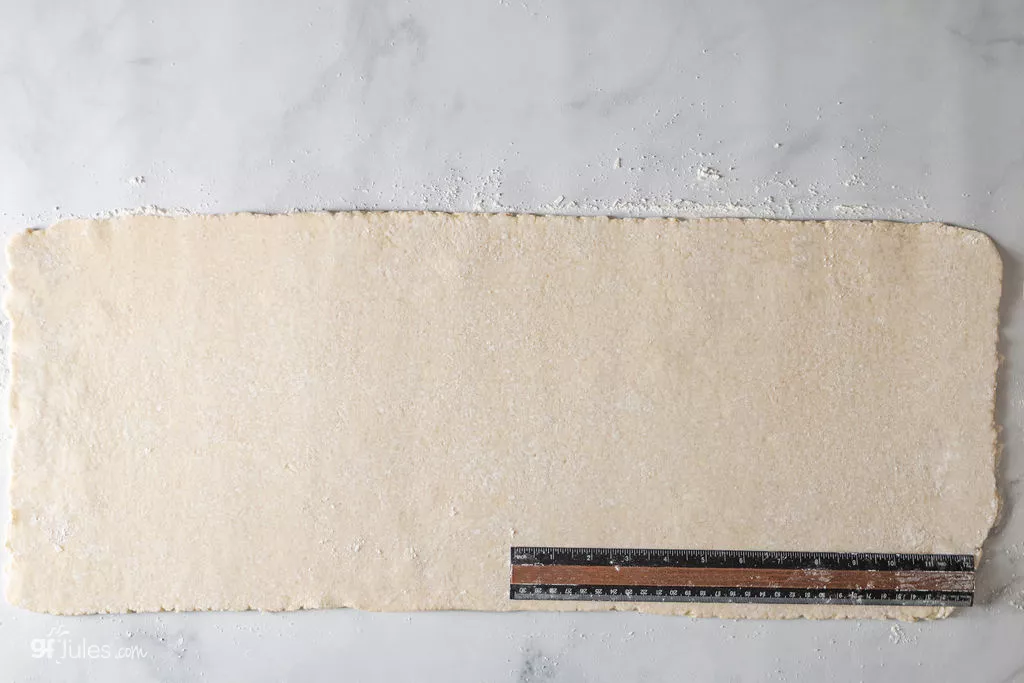
The dough is rolled out again — this time to a much larger dimension — and cut into triangles for traditional croissants or long strips for gluten free pain au chocolat.
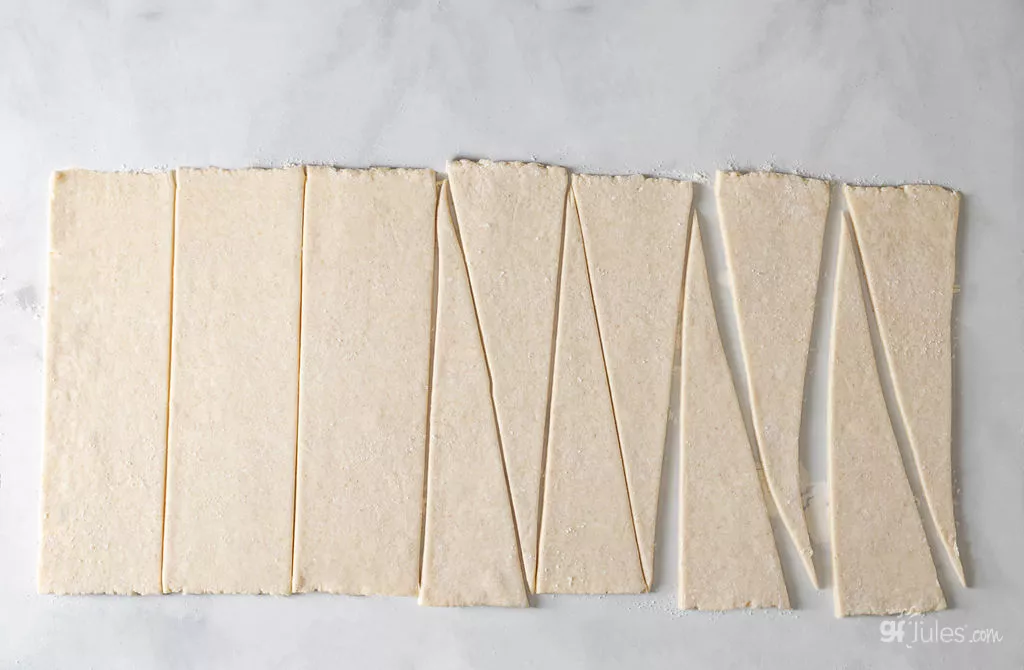
A pizza wheel cutter or pastry wheel is the best tool for this type of cutting (pastry wheels are available on my site).
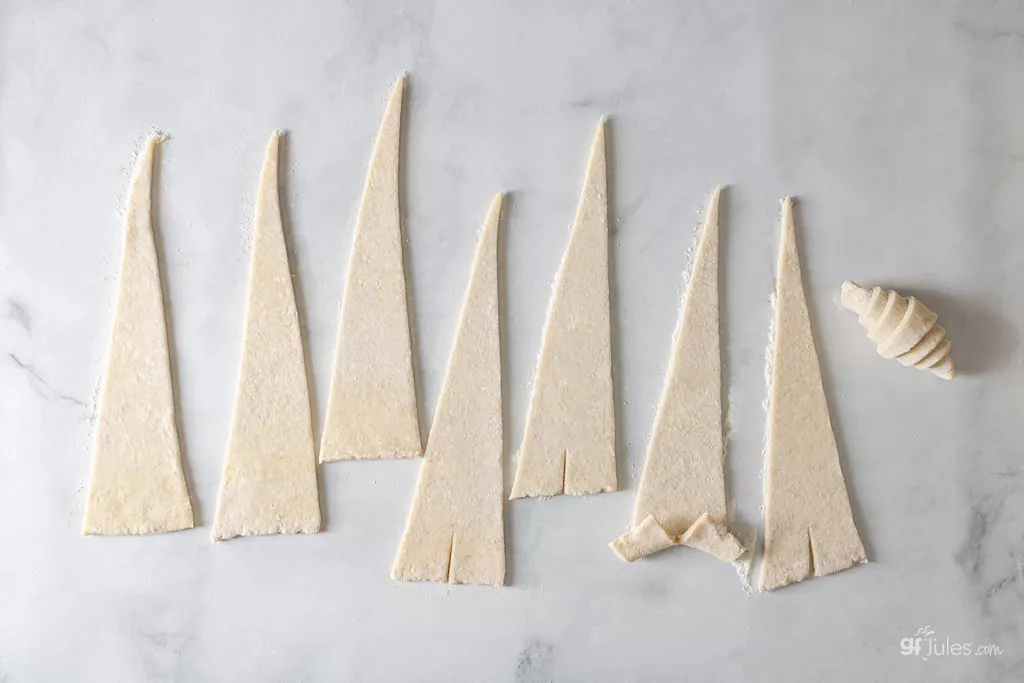
The shaping process is a simple cut-and-roll action (just like making homemade gluten free crescent rolls) that is easy when the dough is cold; if it’s too sticky, put it back into the refrigerator or you can dust with more gfJules Flour.
Remember not to handle the dough too much or melt the butter. If you have to put it back into the refrigerator — do it!
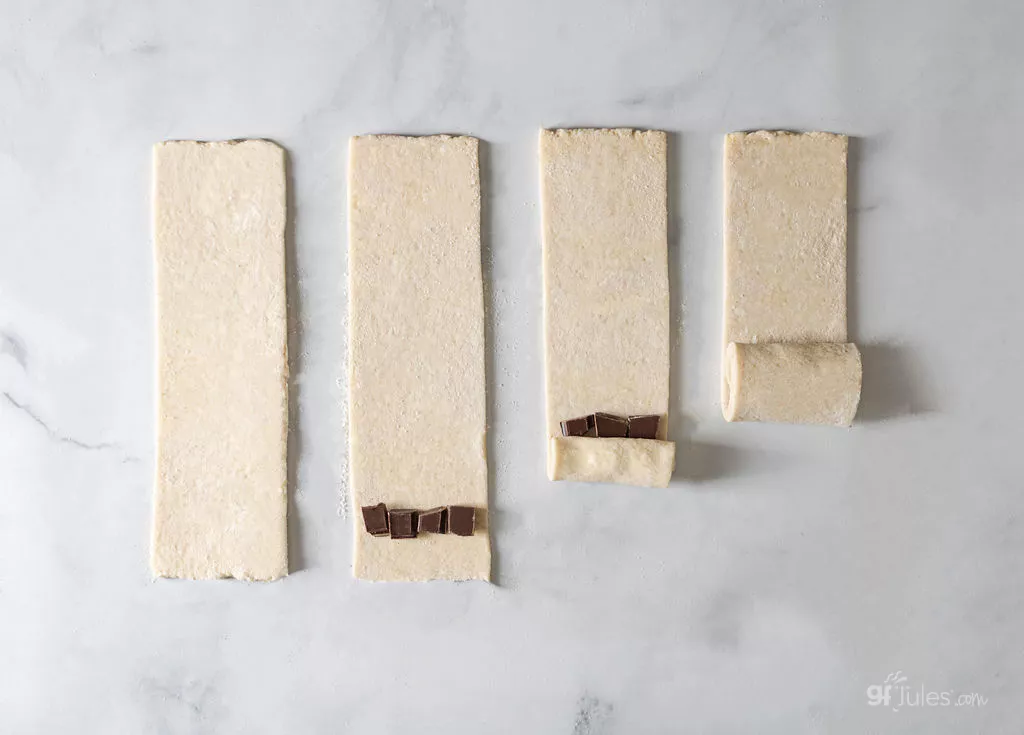
For gluten free pain au chocolat, roll the chocolates up, tucked inside the dough, and lay the rolled croissants on a parchment-lined baking sheet with the seam-side down.
With either style of croissant, brush with an egg wash made of one full egg + 1 tablespoon warm water (or you may use melted butter / vegan butter instead), then set the croissants aside to rise, covered, for one hour. Then brush the croissant dough again with egg wash (or melted butter) before baking to help brown and crisp the edges.
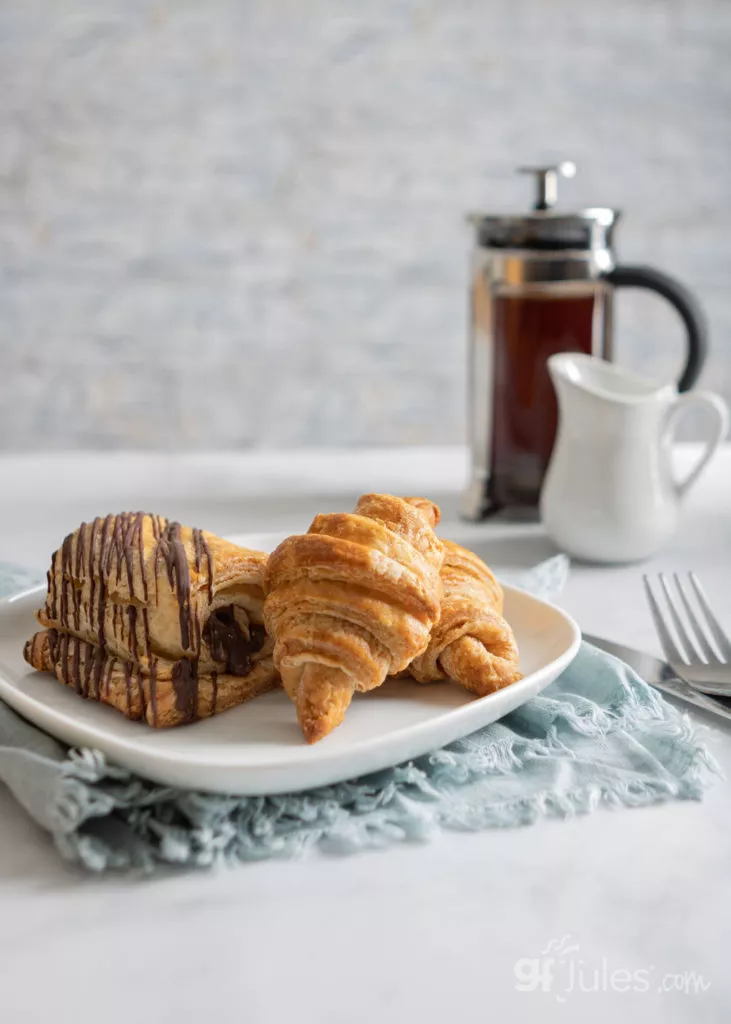
Then the hardest part is waiting for them to come out of the oven because we’re basically waiting for heaven on a plate.
Chef Mora said this about working with the gluten free croissant dough made with my award-winning gfJules Flour:
I’m so glad to have these after a decade of not being able to eat croissants. This dough is so easy to handle and roll out. When they are freshly baked the outside is very crispy and the inside is so soft and buttery. My favorite is having the pain au chocolat. I can’t wait to also try using this dough for other applications, such as almond croissants or kouign amann.

I am so excited to hear what you think when you try this recipe! Will you make a traditional gluten free croissants or a gluten free chocolate croissants? Share your pictures in the comments below!
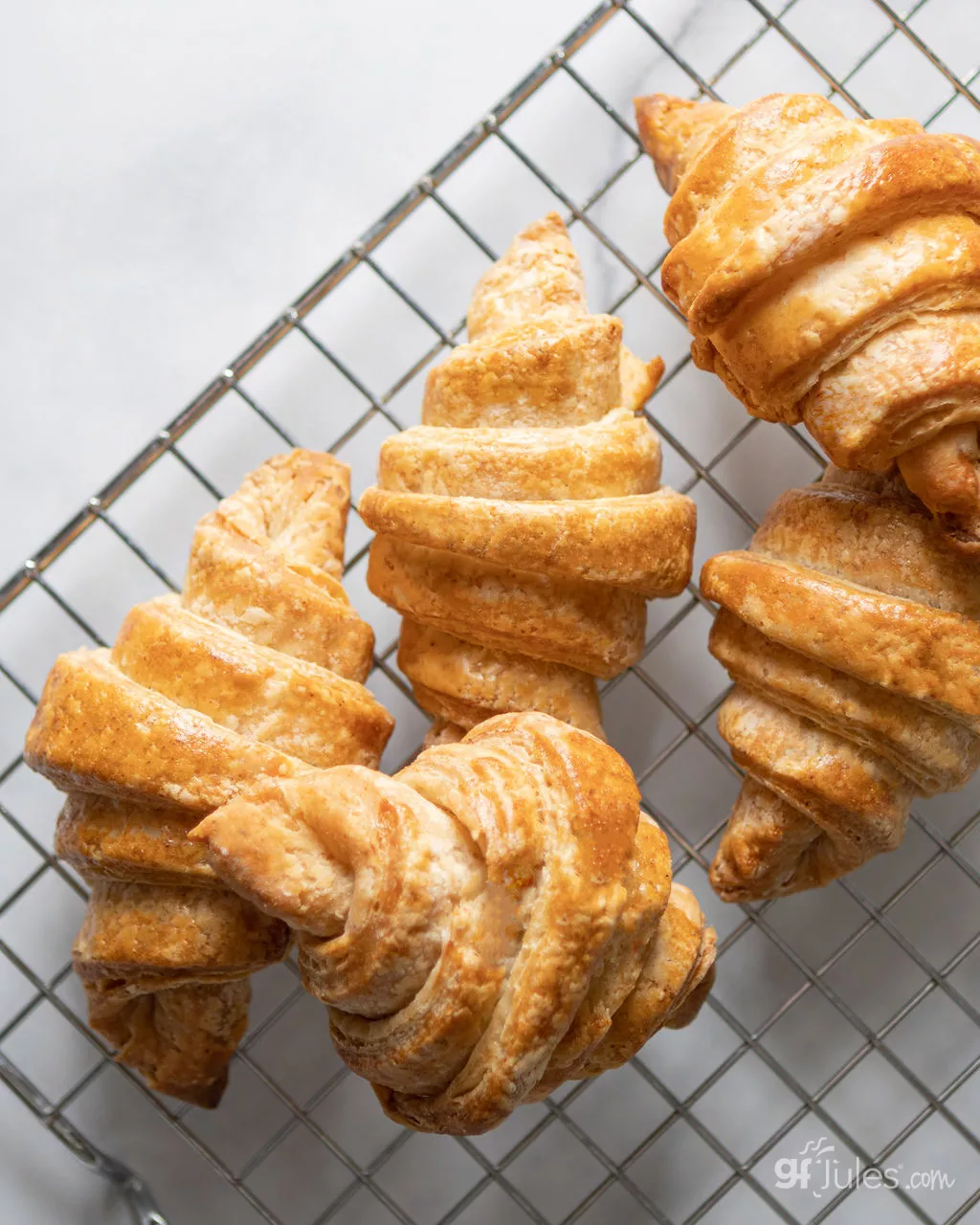
Gluten Free Croissant Recipe
Ingredients
Gluten Free Croissant Dough
- 3 cups (405 grams) gfJules® Gluten Free All Purpose Flour
- 2 packets (14 grams) instant/quick rise yeast (like Red Star®)
- 1/2 cup + 1 Tablespoon white sugar
- 2 1/2 teaspoons salt
- 1 Tablespoon + 2 teaspoons (17.5 grams) baking powder
- 1 Tablespoon + 1 teaspoon (12 grams) psyllium husk powder
- 2 ounces (56 grams) melted butter or vegan butter (like Earth Balance® Buttery Sticks, not Spread)
- 1 1/4 cups (10 ounces/283 grams) warm water
- additional gfJules® Flour for dusting
Butter Block
- 6 ounces (170 grams) butter or vegan butter, softened (like Earth Balance® Buttery Sticks, not Spread)
for Chocolate Croissants
- 5-6 ounces chopped high quality milk or dark chocolate
Egg wash
- 1 large egg + 1 Tablespoon water whisked (egg-free: use melted vegan butter)
Instructions
- For butter block, allow butter to soften to room temperature. Place between two pieces of parchment or wax paper. Using rolling pin, crush butter and roll out to 8”x6”. A spatula or bench scraper can be used to square off sides evenly. If butter gets too soft, it can be placed briefly in the fridge to unstick from parchment paper, but butter should be soft and pliable when enclosing in dough.
- To make dough, whisk together all dry ingredients (including quick rise yeast) in a large mixing bowl. Combine water and melted butter in a separate bowl. While mixer is running with paddle attachment, gradually add liquids. Allow dough to come together, then increase speed to medium and mix until very soft and evenly mixed, about 1-2 minutes.
- Remove from bowl and knead lightly to bring dough together. It should not be crumbly, so add more warm water if needed.
- Place dough on floured surface and roll out to 14”x10”.
- Brush off excess flour from top of dough and place butter block on bottom half of dough, leaving some space along bottom and sides of butter in order to seal dough. Fold top half of dough down over butter and seal dough all around butter block.
- Give dough a quarter turn and roll out again after sealing butter. Continue flouring above and beneath the dough as necessary so dough does not stick. Roll out dough to 16”x10” to make first turn. If butter or dough gets too soft at any point, wrap and place in fridge for 30 minutes to an hour.
- Once dough is rolled out to 16”x10”, brush off any excess flour and fold top of dough down towards the center of dough. Fold bottom half up towards the center as well (like a book). Brush off any excess flour again, and give the dough a quarter turn; fold top portion down and the bottom portion up again, like a book.
- Repeat these book fold steps one more time. If necessary, wrap dough and refrigerate between folding in order to keep the butter from melting.
- After completing second set of book folds, wrap dough and place in fridge for one hour.
- Roll out dough again to 10”x25”. Using a pastry wheel, pizza cutter or a very sharp knife, mark dough along top and bottom at every 3” or for larger croissants at every 5”. Cut straight through from top to bottom marks. Leave as rectangular strips if making chocolate croissants. For plain croissants, cut diagonally across strips of dough to make long triangles.
- Brush off any excess flour from dough before shaping, as the flour will make it more difficult to get the dough to stick to itself in shaping.
To make Gluten Free Chocolate Croissants:
- Place a few pieces of chocolate along bottom of each dough strip. Roll up slightly to cover, and then add another row of chocolate and roll up remaining dough. Place on sheet pan, seam side down. Cover with plastic wrap and allow to rise in a warm place for one hour.
To make Original Gluten Free Croissants:
- Take triangular strips of dough with point facing away from you. Cut a small slit on bottom of strip. Spread pieces apart and roll up croissant tightly. Place on sheet pan, seam side down, and cover with plastic wrap. Allow to rise in a warm place for one hour.
To Bake:
- While croissants are rising, preheat oven to 400°F.
- After rising, brush croissants with egg wash (1 full egg whisked to mix with 1 Tablespoon warm water) and place in preheated oven. Bake until evenly browned, about 35-40 minutes. For egg-free recipe, brush with melted butter, though croissants will not brown as much.
- Allow to cool on cooling rack. Best when freshly baked, but can be reheated to eat the following day. For chocolate croissants, melt some additional chocolate and drizzle over baked croissants.
To Freeze and Bake Later:
- Follow all the recipe steps to shape the dough (for either type of gluten free croissant) but instead of proofing, wrap each croissant individually in plastic and place in a freezer bag. Place the freezer bag into the freezer and store for up to one week. (these may keep longer, but we only tested them for one week)
- When serving, remove from the freezer, unwrap and place on a parchment-lined sheet pan. Cover the croissants on the tray with plastic wrap and set aside to come to room temperature for about 2 hours.
- Brush with egg wash or melted butter, recover with plastic wrap, and place in a warm location to proof for one hour.
- Brush with egg wash or melted butter again and bake as directed above.
** Please keep in mind that nutrition information provided is per serving, which may vary. While we have taken care to provide you with the most accurate nutritional values possible, please note that this information may differ significantly depending on the exact ingredients and brands that you choose to use to make this recipe. Additionally, where options are given for ingredients, the resulting calculation may include all ingredient options instead of only one per line, skewing the totals significantly.
Pin for later!



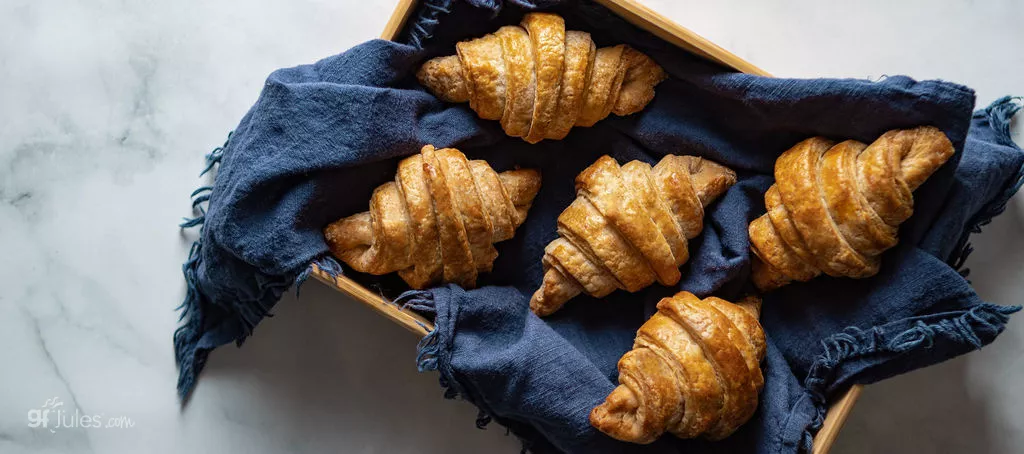











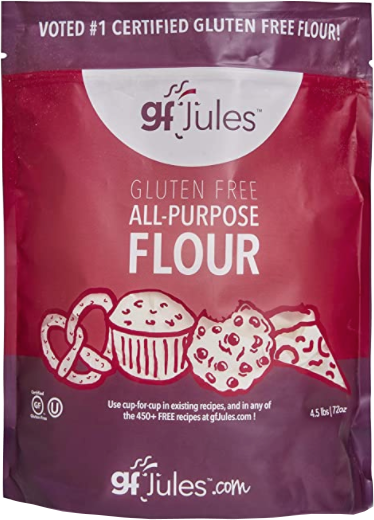
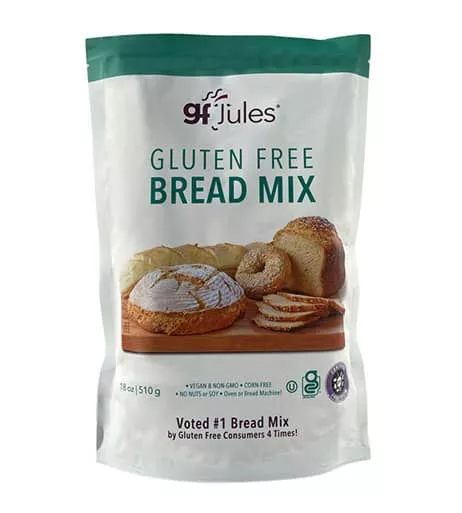
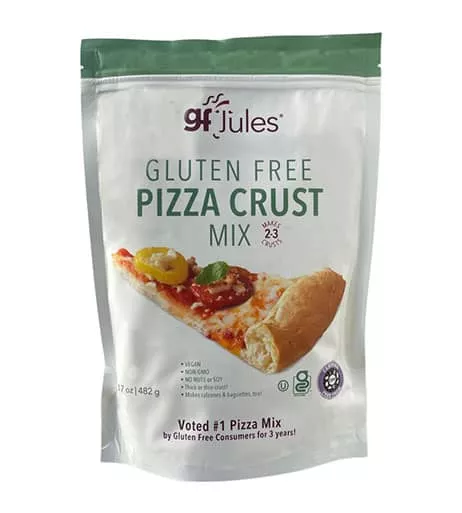
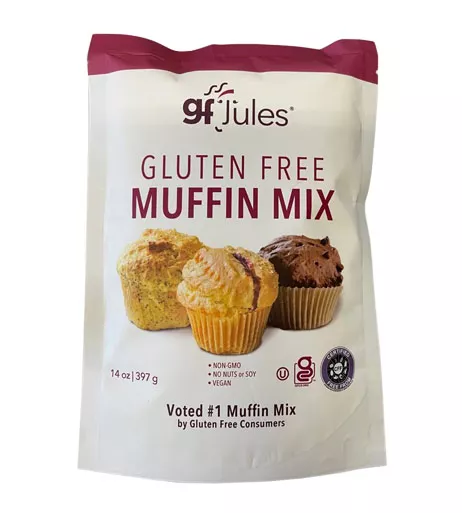






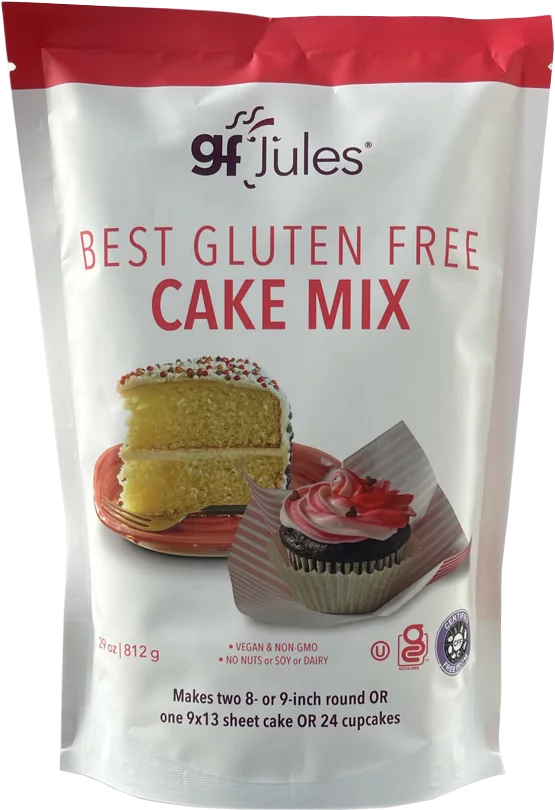
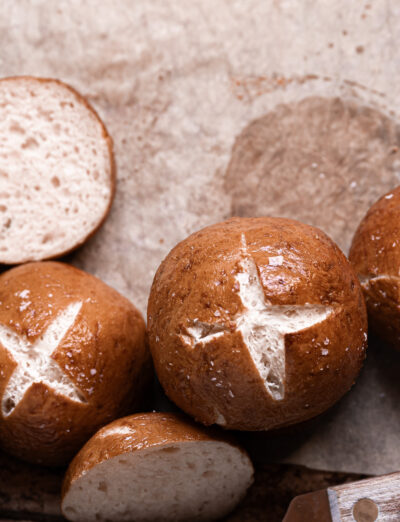
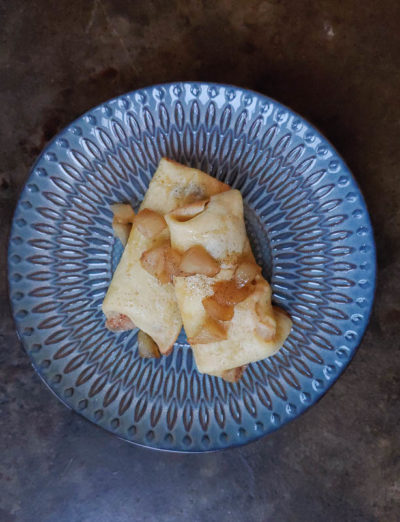
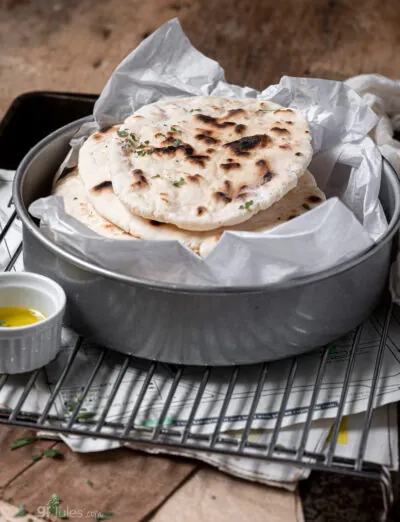



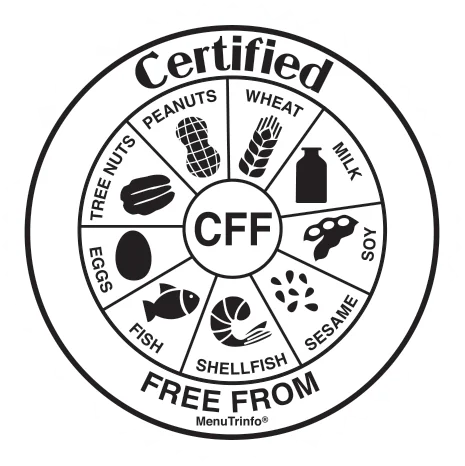




Currently making these right now, with the shaping technique of this recipe, and the dough of the recipe for the puff pastry you reccomend… they’ve been in the oven for about 22 minutes at 400f and they look done… I’m worried 30 minutes is even too much time at that temperature
Gut feelings here, and every oven is different! Take them out if you think they’re already done!
~jules
My Mother and my first attempt at Gluten free croissants! We made some ham, Swiss and jalapeño ones at the bottom there. We struggled a little keeping the dough cold as our dairy free butter sure wanted to be soft. But overall great for first try! Thank you! Happy Thanksgiving.
Oh my goodness, Adrienne, your first attempt at gluten free croissants, and dairy-free, as well!? They look professional grade! How lovely that you had these in time for Thanksgiving!!! Thank you so much for taking the time to share a photo and your baking success with me!
~jules
Jules,
I’ve been craving croissants like I had in France and wondered if you had a recipe—Walah! As I’ve not tried anything with pastry dough before, I have a question about butter choices. My options are either Earth Balance or an English Goat Butter (Cow butter doesn’t agree with me). Do you have a thought as to which might work better? Did you test your recipe with Earth Balance? Thanks for all you do for us!
Hi David,
English goat butter sounds divine, actually! The recipe was developed with butter and tested with Earth Balance Buttery Sticks, which I’ve always found is a close second to butter, but the goat butter should work very well, too! Enjoy the recipe and let me know which you try!
~jules
I would LOVE to try this recipe but I have a couple of questions. Since I live in Sweden, a lot of the products that you use are unavailable, so I would have to use another brand of gluten free flour (Finax) that doesn’t have xanthan gum in it. I have xanthan gum but wondered how much I should use? also, I only have active dry yeast which would need to be activated. Do you have any suggestions as to what I should use to activate it so it doesn’t dry out or make the dough too wet?
Also, you don’t prep the phyllium husk powder in water to make a gel? just add it to the dry ingredients?
The psyllium in this recipe is just added with the dry ingredients, yes.
~jules
Hi Brittany, I’m going to point you to a few articles for information on your questions. I think that will be the easiest way for you to get the answers you seek! The first article is about gluten free flour blends. This article also has information on xanthan gum, but here is a more comprehensive article on baking with gums. Since I don’t know anything about the blend you’re using, you can compare it to the ones I discuss in that article. The next is an article about yeast and how to best proof regular active dry yeast.
I hope that helps!
~jules
I tried making this but had some issues, not sure where i went wrong, but they kind of exploded during baking. Wondered if you could give me an idea of what went wrong? Ftr, they tasted really good and were very flaky, they just didnt look right 🙂
Thank you for any help,
Josh
Hi Josh, I’m so glad they tasted good and were really flaky — definitely the most important part!!!
I’m not sure what could have happened about them exploding … I wonder if it was an oven temp thing? There is a lot of butter in those babies, so if the oven is too hot, I suppose there could be a scenario where the butter could bubble up and out. Do you have an oven thermometer?
~jules
Hi Jules!
Thanks so much for sharing this recipe! I’m about to give your recipe a try and had a question about sugar. What function does the 1/2 cup plus of sugar serve in the recipe? Is it present primarily for flavour, or does it play a significant role in the recipe’s success? Could it be reduced? Is one tablespoon of coconut sugar enough to feed the yeast? I haven’t had white sugar in over 20 years and am craving salty/buttery croissants over sweet…
Thank you!
HI Julie! I’m so sorry I missed seeing your question earlier! The sugar plays a couple roles here, so cutting it out entirely will change the success of the pastry, but you could cut it back, and you could absolutely change it to coconut sugar instead, although that is a bit heavier and the pastry will be darker because of it (I’m sure you knew that!). 1 tablespoon coconut sugar is enough to feed the yeast, but again, some additional sugar is needed for the composition of the dough, so I would still recommend adding a bit more to give yourself the best chance of success with the dough.
~jules
Wonderful! Thank you so much!
I tried with just a couple tablespoons of white sugar, no coconut sugar yet, and they were amazing. We made both pain au chocolate and croissants successfully. It took about 5 hours! Half of them were quickly eaten by my spouse, who is not celiac, cause they were so good! They were just as delicious as I remembered croissants tasting more than 15 years ago! I had tears rolling down my cheeks!
I’ll try a second batch soon using coconut sugar. I’ll let you know how it goes.
Oh Julie, this is music to my ears! I’m thrilled for you (and for your spouse, although tell him to save some for you next time!! LOL). Thanks so much for letting me know! I can’t wait to hear about more recipes to come, and about how they turn out with coconut sugar! If you get a chance to snap a pic next time and to share, please do! Here’s to delicious gluten free croissants!!!!!
~jules
This recipe did not work at all. Super disappointed
Hi Lisa, I’m sorry to hear that the recipe didn’t turn out for you. Can you give me a little more information about what flour you used, and other ingredients? What happened, exactly and how did they not turn out? I’d love to be able to help for next time, if I could.
~jules
Hi there,
Wow, can’t wait to give this recipe a try!! I was hoping to make these for Christmas breakfast. If you freeze the dough once they are shaped, would they be OK to defrost on the bench overnight, and then bake in the morning? Thanks 😊
Hi Rosie, I haven’t tried that yet, but there’s no reason I can think of that the method you describe wouldn’t work. Since you’re planning on doing this for an important occasion though, I would strongly encourage you to practice before the big day. Enjoy this recipe!!
~jules
Please make a video of how to make the croissants. Those of us who are new to baking with gf flour could use the visuals to support us!
I will add it to my to-do list, Julia! In the meantime though, I do hope all the step-by-step photos help with making these gluten free croissants! The best way to learn is just to get in there and DO it!!!
~jules
Kouign Amann??
Yes, please 🙂
I’m eager to see how your croissant Dough might make these yummy treats for our morning coffee
I have access to a reversible dough sheeter. Could I use this instead of hand rolling everything out? I would assume that my dough would have to be very chilled prior to rolling and folding.
Hi Dee – yes! If you’re lucky enough to have a sheeter, use it!! And yes, the dough and the butter need to be very cold and I would recommend putting it back in the fridge often during the process for best results. Let me know how it goes!
~jules
I was so excites to find and try this gfree croissant recipe, and then so disappointed. I purchased your All-purpose flour and measured everything with a scale. Yet my croissants had the texture of biscuits and tasted off, as if they had too much baking powder. 1Tbl + 2 teaspoons does seem like a lot. Please tell me what I may have done wrong. I really want to be able to make, eat and share them.
Hi Sara, my best guess is that you either overworked the dough or allowed it to get too warm while working with it, which then caused the butter to be absorbed into the dough before baking. This will eliminate the layers and make more of a biscuit-y texture. It’s important to be mindful of all that while working with croissant dough (gluten-free or otherwise!) to achieve the right texture.
If possible, keep chilling the dough as often as necessary so it doesn’t get too soft.
Did you make the butter block or add the butter into the mixer and allowed it to mix together? In any case it sounds like the butter just got absorbed into the dough and wasn’t able to create layers when baking.
Regarding the baking powder, I haven’t heard of any issue with the baking powder giving a strange flavor; that’s common with baking SODA, but not with baking powder. Is your baking powder stored with other ingredients where it could absorb odors, as in the refrigerator?
I hope these ideas help!!
~jules
Thanks so much Jules for your reply.
I keep the baking powder in a cupboard and use a good brand. I did make the butter block and returned the dough to the fridge a couple of times. I’ve never made croissants before, gfree or otherwise so it was hard to judge the dough. Not one to give up easily, I’ll give it another shot soon.
Excellent!!! I’m so glad to hear you’re going to give it another go!!!! Please keep me posted!
~jules
If I wanted to prep these the night before and finish up in the morning for ultimate freshness at breakfast, where could I pause and leave the dough in the fridge? Before or after proofing? Thanks!
Hi Juliana, as with the freezing and baking directions, I would recommend refrigerating them before proofing.
You could shape them and place them on parchment-lined baking sheets wrapped well in the fridge, then remove in the morning and set aside to come to room temperature for about an hour.
Brush with egg wash or melted butter, recover with plastic wrap, and place in a warm location to proof for one hour.
Brush with egg wash or melted butter again and bake as directed.
Let me know how it goes!
~jules
Hello, what can i use instead of psyllium husk powder?
Hi Rola, psyllium husk is what’s recommended here, but you could try another gum in its place. Check out this article on making the exchange.
~jules
I’d love to make the croissant, but I don’t have a stand mixer. Is there another way to mix the dough? I have electric beaters. Also, can a different sweetener, like monk fruit or coconut sugar replace the white sugar? Thanks! Looking forward to baking with your flours.
Hi Anna, you could definitely try with the electric beaters, and just work the dough down the beaters with a rubber spatula if it starts to crawl. You can always resort to a wooden spoon and bowl with lots of elbow grease — it’s about making sure the dough is mixed well, so however that gets done! Monk fruit should work ok as well, but I haven’t tried it yet in this recipe, so let me know if you get a chance to try it first!
~jules
Fantastic! Thanks for the reply and info. Let you know how it rolls : )
Aloha from Maui
Wonderful!
~jules
Truly blown away. I’ve made “traditional” croissants before, so I had an idea of what I was in for, but these were SO much easier, the dough was easier to work with, took significantly less time, and just as tasty. The one edit I would make to the recipe – include a bit of time after making the dough to have it chill before adding the butter so the butter doesn’t start to melt. I remembered this step from making them previously, but I didn’t see it in the recipe. I would also love to see recommended thickness. That aside, these were delightful and I very much regret halving the recipe.
I’m thrilled to hear how happy you were with how these gluten free croissants turned out, Holly! And your photo looks amazing!!!!!! Thanks so much for adding your recipe notes, as well. Always appreciated! Happy baking!!!!!
~jules
It can be done. I made the chocolate croissants, and they were amazing! After over 10 years of gluten-free baking (including a lot of baking flops), I really did not have high hopes that these would turn out. However, I love baking experiments, so I had to give them a try. I am glad I did because now I know I can make gluten-free croissants whenever I want. Thank you, Jules, for all you do for the gluten-free community.
I’m so excited for you, Jennifer, and for this gluten free croissants recipe!!! Thank you so much for taking the time to share your gluten free chocolate croissants picture — I’m drooling!!!!!!!!!!
~jules
Thank you, Jules! I had the most amazing GF croissants in Italy, and it’s so hard to find them in the US. Now I can find them in my kitchen! First try, and they’re beautiful!
You nailed it, Jessica!!! I’m thrilled you tried this recipe right away … and you were rewarded with delicious success! These gluten free croissants are gorgeous!!!!
~jules
I am sooo excited to try the gluten free puff pastry recipe. I want to make Spanakopita with the puff pastry. I also will use dairy free butter. However, before I do, I want to view the video but cannot seem to get it to work. After the ad comes on, it just generates in a circle over and over again. I have had this same issue with some of your other videos. I will keep trying. Thanks for this gorgeous recipe Jules.
Your recipes are always delish? In this one for croissants, instead of psyllium can we use finely ground flaxseed.? Looks like the purpose is to bid and add fiber, which flaxseed also does. Thank you!
Hi KD, the psyllium is to add even more stretch to the dough. You could try flax as an alternative if you don’t have psyllium, but the results won’t be exactly the same. Let me know how it goes!
~jules